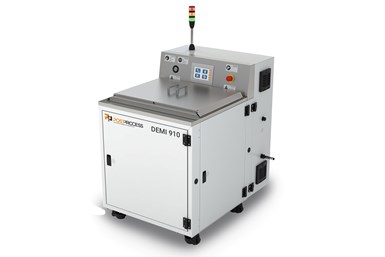PostProcess’ Resin Removal Streamlines Model 3D Printing for Carbon Customers
PostProcess Technologies’ DEMI 910 automated resin removal solution is now compatible with Carbon DPR 10 resin.
PostProcess’ DEMI 910 was developed specifically for use in the Carbon Ecosystem and with Carbon’s Digital Light Synthesis (DLS) printing.
PostProcess Technologies’ automated resin removal solution is now compatible with Carbon DPR 10, a proven material used in dental and orthodontic model production and a range of other applications, the company says. The PostProcess DEMI 910 was developed specifically for use in the Carbon Ecosystem and with Carbon’s Digital Light Synthesis (DLS) printing.
With a specialized fixture design, it is said the DEMI 910 is capable of automated resin removal for an entire build platform from a carbon large-format L1 Printer or two build platforms from a carbon high-resolution M2 Printer. Leveraging proven technology and driven by Automat3D software, the system is designed to significantly improve productivity for Carbon’s 3D printing workflows, the company says.
According to the company, this solution yields improvements in user experience, efficiency and throughput when compared to cleaning with isopropyl alcohol. The PLM-450-SUB detergent from PostProcess is chemically compatible with Carbon DPR 10 resin, and is said to result in consistent, resin-free parts.
In addition to Carbon DPR 10, the DEMI 910 and PLM-450-SUB detergent are compatible with other Carbon resins, including EPU 41, EPX 82, MPU 100, RPU 70, RPU 130, UMA 90 and Loctite 3D IND 405.
The company says the DEMI 910 was designed to deliver scalability and efficiency for AM users. Expanding its Carbon partnership to include compatibility with DPR 10 is said to lead to a streamlined and more sustainable process for Carbon customers in the oral health and other industries.
Related Content
-
Durable, Waterproof 3D Printed Casts: The Cool Parts Show #58
Recovering from an injury with an ActivArmor cast means that patients can exercise, bathe and live life while they heal. We get a firsthand look at the solution in this episode of The Cool Parts Show.
-
Q&A With Align EVP: Why the Invisalign Manufacturer Acquired Cubicure, and the Future of Personalized Orthodontics
Align Technology produces nearly 1 million unique aligner parts per day. Its acquisition of technology supplier Cubicure in January supports demand for 3D printed tooling and direct printed orthodontic devices at mass scale.
-
FDA-Approved Spine Implant Made with PEEK: The Cool Parts Show #63
Curiteva now manufactures these cervical spine implants using an unusual 3D printing method: fused strand deposition. Learn how the process works and why it’s a good pairing with PEEK in this episode of The Cool Parts Show.














